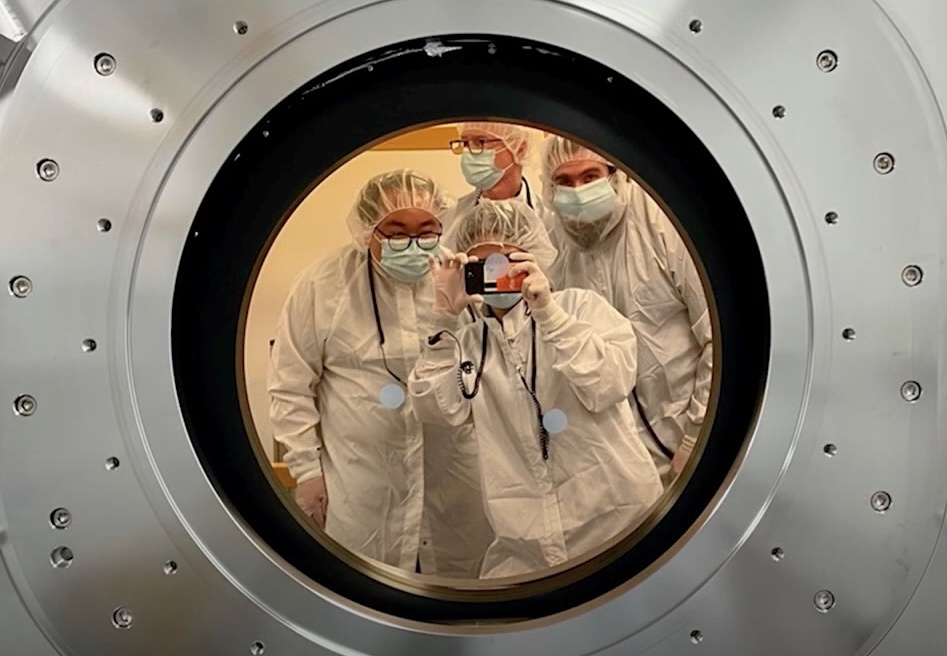SPHEREx put to the test in KASI thermal vacuum chamber

SPHEREx team members seen reflected in the KASI chamber cold-filter window. The window is mounted on the front of the chamber where, just behind the window is the telescope entrance pupil. The window is a half meter diameter piece of pure sapphire coated with gold, which is used to attenuate infrared background present in the lab environment. Clockwise from top: Dr. Stephen Padin, Dr. Phil Korngut, Dr. Chi Nguyen and Dr. Howard Hui. Credit: SPHEREx team, Caltech, JPL.
In this timelapse movie, scientists and engineers can be seen at Caltech preparing NASA’s SPHEREx space telescope for tests inside a vacuum chamber provided by KASI. The process took more than two weeks and involved more than 20 people.
In this timelapse movie, scientists and engineers can be seen preparing NASA’s SPHEREx space telescope for tests inside a vacuum chamber at Caltech that simulates the environment of space. The process took more than two weeks and involved more than 20 people. The mission, which is planned to launch no later than 2025, will survey hundreds of millions of galaxies near and far. At the start of the movie, the telescope’s three so-called V-groove chillers can be seen as rings at the bottom of the structure. These chillers cool SPHEREx by radiating heat from the instrument to the cold of space (the telescope’s visible- and infrared-light detectors are very sensitive to temperature, so the telescope and detectors have to be kept very cold). Technicians can be seen wrapping gaps in the V-groove area of the telescope in a foil material so that light does not enter from the back during the tests. The telescope is then loaded into a special thermal vacuum chamber, which was built by team members at the Korean Astronomy and Space Science Institute (KASI). The chamber simulates the chilly temperature of space, allowing the team to test the telescope’s focus on the detectors. The V-grooves and telescope are cooled by active systems in the chamber for the tests. Near the end of the movie, a custom-made window is installed in the chamber that is made of sapphire and coated in gold. The window allows the team to project a simulated star into the chamber while reflecting heat from the laboratory. A series of measurements will test that the telescope is in focus and stays in focus through the shaking of launch. The highly reflective sapphire window also provided the team with an opportunity for a “selfie,” seen at the end of the movie.
Recent News
SPHEREx has made detailed multi-spectral observations of interstellar comet 3I/ATLAS, detecting an abundance of carbon dioxide gas in its coma (the extended gaseous atmosphere of a comet) and water ice in its nucleus. The observations were made between Aug. 7 to Aug. 15, when the object was about 290 million miles (470 million kilometers) from the Sun.
Read MoreNASA’s newest astrophysics space telescope launched in March on a mission to create an all-sky map of the universe. Now settled into low-Earth orbit, SPHEREx (Spectro-Photometer for the History of the Universe, Epoch of Reionization, and Ices Explorer) has begun delivering its sky survey data to a public archive on a weekly basis, allowing anyone to use the data to probe the secrets of the cosmos.
Read MoreBuilding SPHEREx in a Caltech Basement
How a NASA space telescope came together in a university lab
Read MoreAfter weeks of preparation, the space observatory has begun its science mission, taking about 3,600 unique images per day to create a map of the cosmos like no other.
Read MoreNASA’s Newest Space Telescope Recognized at New York Stock Exchange
The SPHEREx astrophysics observatory will help answer big questions about the origins of our universe, of galaxies, and the ingredients for life in our galaxy.
Read More



